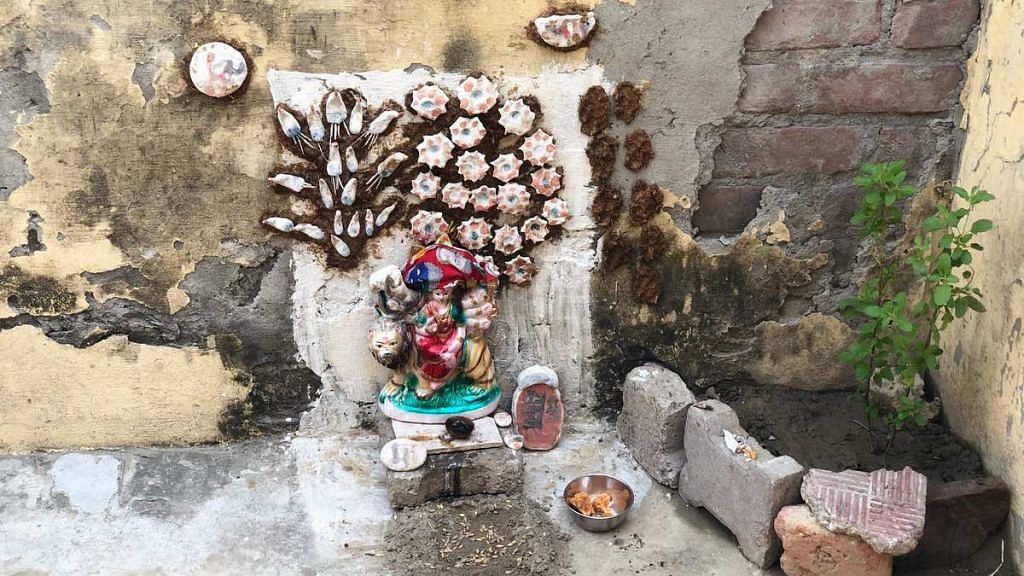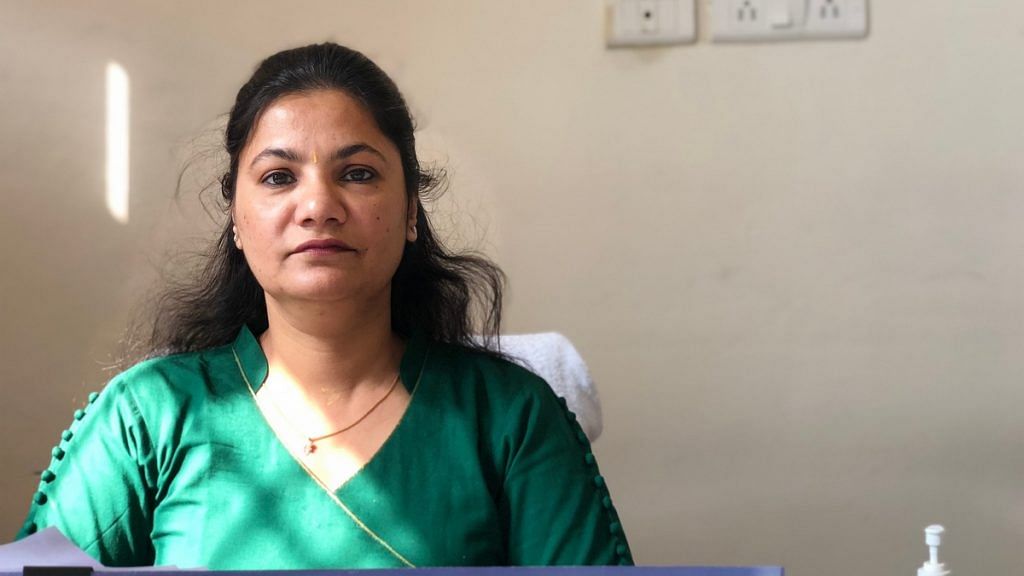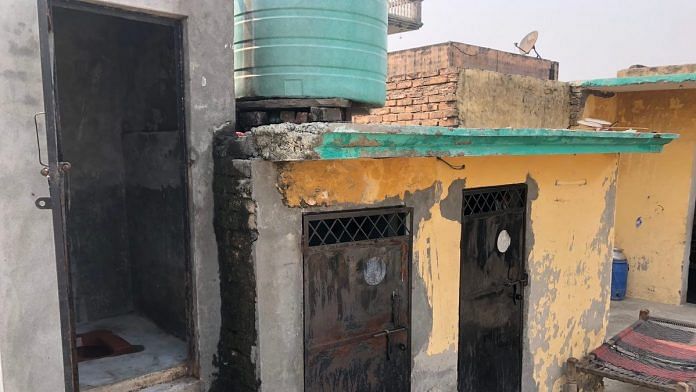Panipat/Rohtak: On 13 October, Rajni Gupta, Panipat’s women protection and child marriage prohibition officer, received a call from an informer, telling her that a woman in Rishpur village, 20 km from the city, had been kept locked up inside a toilet in her house for more than a year. The informer told Gupta to be careful — if the woman’s husband got to know, he would not open the door.
Forty minutes later, Gupta was in the village along with four constables — two men and two women. They got lucky — the door to the house was open, and in a toilet measuring three feet-by-three feet on the first floor, they found 38-year-old Ramrati. The mother of three was skeletal when she was rescued, weighing just 25 kg.
Her husband Naresh was also at home, but Gupta said: “We simply barged into the house. Naresh was on the ground floor. We asked him where his wife is. He led us to the first floor and opened the toilet.”
Naresh had apparently locked Ramrati up after she was labelled ‘a mad woman’ due to a mental health issue. She was rushed into medical care, and is undergoing treatment at the Post Graduate Institute of Medical Sciences in Rohtak, better known as PGI Rohtak.
Behind Ramrati’s plight was a combination of violence against women, the lack of understanding about mental health in rural as well as urban India, and the Covid-19 lockdown. ThePrint travelled to Rishpur, the Panipat Civil Hospital, the One Stop Centre for women in the city, and PGI Rohtak to uncover the story.
Also read: Coronavirus lockdown is a danger for victims of domestic violence. Here’s what to do
The horror she faced
Ramrati’s caretakers at PGI Rohtak say all she has done in the last week is eat. “The doctor has asked us to give her whatever she demands,” said a caretaker who did not wish to be named.
She alleged she was forced to live in the toilet, and wasn’t given food for days. Deprived of food and care, she became extremely malnourished, unable to walk.
Now, she is strong enough to tell her story, albeit in short sentences: “They gave me food occasionally. I mostly ate my food inside the toilet. I sometimes tried to peek outside.”
Gupta recounted the horror of finding her locked in the toilet. “With folded legs and terror on her face, she almost looked like a skeleton. The very image of her with torn clothes sent chills down our spine. In my 12 years of service, I have saved more than 2,500 women from domestic abuse. But this case completely shook me,” she said.

One of the woman constables who rescued Ramrati broke down while recalling the day. Though she refused to be identified, the constable said: “As soon as she was taken out, the first thing she demanded was tea and chapatis. She ate seven chapatis at one go. Dry faeces were stuck to her clothes, and there were lumps in her hair. After she was washed with shampoo and hot water, she saw bangles on my wrist. She then demanded nail paint and bangles.”
‘Madness’ led to confinement, says family
Ramrati was married 17 years ago to Naresh, a landless farmer who had only completed primary school. But somewhere between a year and a couple of years ago, she disappeared from public view — Ramrati herself said she was locked up for a year or so, but neighbours and local administration workers said they hadn’t seen her for over two years.
“We had seen her working in the house, but in the last few years, she was occasionally seen on the first floor. Their three children were growing up, so she wasn’t needed in the house anymore. That’s why she was left to die in the toilet,” said a neighbour, who did not want to be identified.
Ramrati’s relatives refused to come forward and lodge a complaint against Naresh, so rescuing officer Gupta lodged a complaint of domestic violence and wrongful confinement (Section 498A and Section 342 of the Indian Penal Code). Naresh was arrested on 13 October, but was granted bail the next day.
Naresh, 39, told ThePrint: “She is mad. We tried a doctor in the past. We felt embarrassed if she came out in the open. That is why we did what we did.”
His sister Kavita, 35, added: “If you have a mad woman in the house, you have to keep her away so as not to become a mockery in society.”
Dr Mona Nagpal, a psychiatrist at the Panipat Civil Hospital, examined Ramrati after her rescue, and confirmed that she had indeed been suffering from a mental illness.
“There was no coherence in her statements. I found out that she had been suffering from chronic mental disorder for the last 12 years. In the absence of care and food, her condition worsened,” Nagpal told ThePrint.
She blamed the lack of awareness in rural India for the mistreatment of vulnerable women such as Ramrati. “Neither women nor men have any idea of what mental health is. If a woman is seen with the slightest hints of depression and anxiety, she is called names. Many times, families end up visiting godmen to get ‘ghosts’ out of these women,” she said.
Ramrati’s family too said when she showed no signs of recovery, they had made the rounds of a few such babas.
Also read: Sushant Singh Rajput was right to hide his depression, India is no country for mental health
Administration’s negligence & lockdown woes
According to Gupta, there are three agencies that are responsible for the welfare of women — the village sarpanch, anganwadi workers and the nearby police chowki. “In this case, all three were unaware of what was happening in the village,” she said.
Sanchita, one of the three anganwadi workers in Rishpur village, said: “The last time I saw Ramrati was two and a half years ago, when we went for a survey. We demanded a few documents, but she told us that she didn’t have any.”
They never saw her after that. “It was always her husband and children. In the past eight months, our visits became limited because of the coronavirus, and domestic violence became a second priority,” Sanchita added.
An inquiry is going to be initiated against the anganwadi centre for this gross negligence, Gupta said.

Village headman Ravinder Kumar said: “We never saw or heard about Ramrati being kept in a toilet. Later, the gram panchayat got busy with the preparations for coronavirus.”
Naresh and his children have been giving contradictory statements to the agencies — while he says he confined her in the toilet because of societal pressure due to her mental problems, the children have said she wasn’t forced into the toilet.
Gupta said: “We have counselled the minors twice. They seem to be oblivious to the happenings in their household. They maintain silence about their mother. Naresh cooked and fed the children while the mother was confined. This had been the routine for a year.”
Now, the Haryana State Commission for Women has constituted a five-member committee led by Mamta Gaur to look into the case. The panel is expected to submit its report within ten days.
Preeti Bhardwaj, acting chairperson of the HSCW, told ThePrint: “Our investigative team has gone to the village twice and recorded the statements of neighbours. Many have come out and corroborated Ramrati’s version. We are also looking at other angles under the law, since Ramrati’s minor children are also involved in this illegal confinement. The committee will soon submit its report.”
Wider trend of domestic violence under lockdown
The United Nations has said due to the pandemic and lockdowns across the world, cases of domestic violence are expected to rise by 20 per cent. According to this report in The Hindu, domestic violence complaints across India were at a 10-year high during the first lockdown from March to May.
Almost 86 per cent of women who are victims of domestic violence never seek help, the article said.
Dr Nagpal at the Panipat Civil Hospital said: “Women in distress could not seek help through police, helpline numbers or anganwadi workers during the initial phase of the lockdown. This triggered the situation. After the lockdown was relaxed, we started receiving almost 50 patients a day. We noted that most of them were women, and most of them were suffering from mental disorders because of domestic violence.”
However, Bhardwaj said while domestic violence cases had increased in Haryana in the initial phase of the lockdown, the situation had improved subsequently.
“According to police data and the distress calls we received on 1091 (Haryana’s helpline for women), the trend suggested that the cases of domestic violence during the initial phase of lockdown had intensified. Women were complaining of beatings from husbands, how their phones were snatched away etc.,” she said.
“But in the past few months, the data suggests that violence against women has decreased. According to the Haryana Police’s figures, there are 17 per cent less cases compared to last year. Our own assessment says that from March to September, violence against women has decreased 23 per cent compared to last year,” Bhardwaj added.
However, Isha Verma, the woman in charge of the ‘One Stop Centre’ in Panipat, tells a different story. One Stop Centres are set up under a flagship scheme of the Union Ministry of Women and Child Development, which intends to support women affected by violence in private and public spaces; within the family, the community and at the workplace.
Verma told ThePrint: “We have noted a sharp rise in domestic violence cases during the Covid lockdown.”
She said some cases come to her centre through anganwadis, some through the police, while the rest are women in distress “who reach us themselves”.
Also read: Far from being the solution, Haryana One Stop Centres seem to be adding to women’s problems






